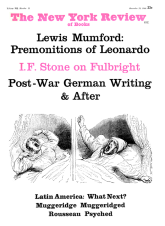In response to:
Counter-Intelligence from the October 20, 1966 issue
To the Editors:
The question of when and to whom to assign the initiation of the Cold War was tackled in “Letters” (Oct. 20) by Arthur Schlesinger, Jr. and Gar Alperovitz, the reviewer of The Secret Surrender, whom Mr. Schlesinger engaged in debate. Schlesinger employs Jacques Duclos’s April 1945 article in Cahiers du Communisme to demonstrate to Alperovitz that the Cold War did not begin with Allen Dulles’s “secret 1945 negotiations with the Nazis.” Moreover, asserts Schlesinger, Soviet-American Cold War antagonism clearly stemmed from actions undertaken by the Stalin regime, not by the US.
May I submit that both historians are engaging in futile pinpointing of the exact start of the Cold War? That in any case Soviet-American animosity goes back a good deal farther than April 1945?
If we must fix upon some obvious date, let me suggest that the Yalta Conference of February 1945 forms a more convincing starting point for charting the downhill course in Soviet-American relations, a process which had actually set in during the Second World War. As a matter of fact, Stalin’s decision to remove Browder from the helm of the CPUSA—these still were the days when the Kremlin could unilaterally dump foreign Communist leaders—came just at the time of Yalta. And what happened at Yalta which demonstrates the beginning of the freeze in Soviet-American relations?
All the pent-up hostility between the US and the USSR, shelved “for the duration,” floated to the surface. The defeat of Nazi Germany loomed on the horizon, and the whole postwar settlement of Europe clearly lay before these two major powers in the world. This bi-polarity was thrown in relief by the weakness of both France and Britain by the end of the war. And, of course, long before Yalta Stalin and his associates had made it abundantly clear—and not only in pontifical ideological pronunciamentos—that the Soviets considered all of Eastern Europe their exclusive bailiwick, a region to be “liberated” by the Red Army and subject to sovietization.
I recommend that both historians reread (or read carefully for the first time) Chapter XXXII of Robert E. Sherwood’s Roosevelt and Hopkins—An Intimate History. In this chapter entitled “Beginnings of Dissension,” Sherwood, playwright and part-time historian (the best kind, evidently), details the process by which the Soviet-American “strange alliance” had deteriorated by the winter of 1944-45. Pointing to March 1945, Sherwood reports in his chapter on the Yalta Conference:
By the middle of March 1945 a situation had developed in Rumania which indicated that the Russians were determined to set up governments in Eastern Europe in conformance with their own interpretation of the word “friendly” and without regard for the principles of the Atlantic Charter which had just been reaffirmed…. It was beginning to appear evident that a complete deadlock had developed among the British, Russian, and American conferees…. There was now a growing feeling of uneasiness born of the unknown and the inexplicable, regarding the true relationship between the Soviet Union and the United States, Great Britain, and the other members of the United Nations… It was beginning to be feared that a monstrous fraud had been perpetrated at Yalta, with Roosevelt and Churchill as the unwitting dupes.
A similar description—and dating—of the manifest worsening of Soviet-American relations may be found in George F. Kennan’s Russia and the West Under Lenin and Stalin.
The freezing process had clearly accelerated toward the end of the European phase of World War II.
While it is clear that the Western Allies are not utterly blameless, it is even clearer that Stalin’s Russia played the crucial role in initiating what came to be called the Cold War by committing or instigating political, economic, and military aggression in the 1940s and 1950s. Stalin’s policy of Communist expansionism led to the formation of NATO and the Warsaw Pact Alliance—fungi thriving on the putrescence of the wartime alliance of the Soviet Union and the United States.
Albert L. Weeks
New York University
Michael Korda is right to recall Wolff’s Nazi record, above all to stress that Dulles, a high-level intelligence agent, should have been most skeptical when he was, in fact, most trusting. While Wolff dickered with him (building a “good Nazi” reputation for after the war) he simultaneously reported directly to Hitler himself.
I agree with Professor Weeks that there is little point in trying to define a precise starting date for the Cold War. I had hoped my review suggested as much, for the Dulles episode is important not because it was a starting date, but because it illustrates that we must learn to understand the Cold War as an ongoing interaction involving a complex series of linked actions and reactions, responses and counterresponses. “Causation” becomes a very subtle question; and the ultimate roots of all this, of course, go very deep; they can be traced at least to 1917. Nevertheless, specific events occur at specific times, and it is a fact that the first serious hostilities of what we term the Cold War occurred in March 1945. They were set off when suspicions arising from Dulles’s negotiations coincided with and reinforced difficulties over the Polish issue. Interestingly, Professor Weeks pinpoints not one, but two “starting dates” for the Cold War, among these March 1945.
This Issue
December 29, 1966



